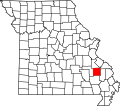2010 census
As of the census [19] of 2010, there were 3,985 people, 1,669 households, and 995 families residing in the city. The population density was 920.3 inhabitants per square mile (355.3/km2). There were 1,902 housing units at an average density of 439.3 per square mile (169.6/km2). The racial makeup of the city was 96.41% White, 0.28% Black or African American, 0.55% Native American, 0.58% Asian, 0.05% Native Hawaiian or Pacific Islander, 1.20% from other races, and 0.93% from two or more races. Hispanic or Latino of any race were 1.83% of the population.
There were 1,669 households, of which 30.9% had children under the age of 18 living with them, 41.3% were married couples living together, 13.7% had a female householder with no husband present, 4.6% had a male householder with no wife present, and 40.4% were non-families. 36.1% of all households were made up of individuals, and 18.4% had someone living alone who was 65 years of age or older. The average household size was 2.31 and the average family size was 2.97.
The median age in the city was 38.6 years. 24.4% of residents were under the age of 18; 9.2% were between the ages of 18 and 24; 23.2% were from 25 to 44; 23% were from 45 to 64; and 19.9% were 65 years of age or older. The gender makeup of the city was 46.3% male and 53.7% female.
2000 census
As of the census [4] of 2000, there were 3,928 people, 1,625 households, and 1,010 families residing in the city. The population density was 919.9 inhabitants per square mile (355.2/km2). There were 1,817 housing units at an average density of 425.5 per square mile (164.3/km2). The racial makeup of the city was 97.76% White, 0.20% African American, 0.33% Native American, 0.59% Asian, 0.41% from other races, and 0.71% from two or more races. Hispanic or Latino of any race were 0.69% of the population.
There were 1,625 households, out of which 28.6% had children under the age of 18 living with them, 45.8% were married couples living together, 12.7% had a female householder with no husband present, and 37.8% were non-families. 34.4% of all households were made up of individuals, and 21.7% had someone living alone who was 65 years of age or older. The average household size was 2.28 and the average family size was 2.89.
In the city, the population was spread out with 23.2% under the age of 18, 8.8% from 18 to 24, 24.1% from 25 to 44, 19.4% from 45 to 64, and 24.6% who were 65 years of age or older. The median age was 40 years. For every 100 females, there were 78.1 males. For every 100 females age 18 and over, there were 71.7 males.
The median income for a household in the city was $21,354, and the median income for a family was $27,149. Males had a median income of $27,593 versus $16,729 for females. The per capita income for the city was $13,512. About 17.4% of families and 22.3% of the population were below the poverty line, including 31.4% of those under age 18 and 14.1% of those age 65 or over.


